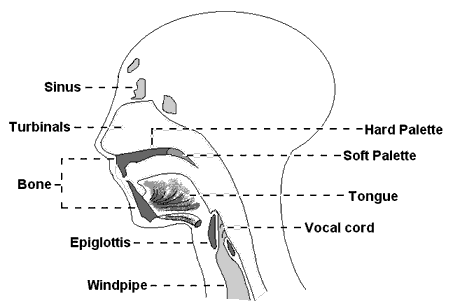
WINDPIPE
The windpipe, or trachea is different lengths and thicknesses in every one of us, and this determines two things: the length determines how high or low your voice is, and the thickness of its walls contributes to your individual tone. Try this: place your palm on your throat, and sing a low note, and you should feel your windpipe vibrating.
Keep it moist with plenty of room temperature water.
VOCAL CORDS
Two cords of tense elastic bands which stretch from the front to the back of the larynx. It is the vibration of these cords which chiefly produce speech and singing. They are controlled by small muscles which we control by will power - this is what produces different notes when we sing.
TONGUE
Your tongue is bigger than you might think! Look at the diagram - it extends right to the base of your throat. Try placing one hand either side of your throat, just under your jaw. Lift your head up, open your mouth wide and stick your tongue out - can you feel your tongue move with your fingers?
The tongue needs to be exercised wellin order to sing intelligibly - it controls our speech.
Try saying an alphabet, and check out how much it moves!
It is impossible to pronounce “L” without it touching the hard palette.
TURBINALS
A large cavity behind the nose, which is used to resonate in order to create brightness when singing with forward placement. Try touching your cheekbones and humming a low note - you should be able to feel the vibration.
SINUS
A hollow cavity within the bone of the skull. There are several, all of which contain air, and communicate with the nose. These will all add a certain amount of resonance to the voice. They all have fancy names: the maxillary sinus, or antrum, the frontal sinus, the ethmoidsinus, and the sphenoid sinus - so now you know!
The main thing about these little hollows is that they determine a lot of the timbre of your voice. You were born with them, and you can’t change them...unless you get flu, in which case they fill up with fluid and pressure increases inside them...which is why your voice sounds funny when you get a bad cold.
HARD PALETTE
The hard palette can be found by running the tongue along the roof of the mouth. It forms a wide arch, and singing using forward placement brings the sound production to this part of the mouth. It causes singing to sound clear and bright in tone. It is really where we need to be forming sound when singing. Combined with the teeth, you can think of this as the ‘sounding board’ of your head.
SOFT PALETTE
Run your tongue along the roof of your mouth a bit further and you’ll come to a soft, fleshy part which is called the soft palette. It is actually a muscular continuation of the hard palette, and singing or speaking using it forms a rounded, dull or soft tone.
EPIGLOTTIS
If you drop your ‘t’s when speaking, and try to say water - “wa’er”, the sound which is produced where the ‘t’ should be is produced by the epiglottis; known as a glottal stop. It can cause damage to your voice, as the vocal cords bang against each other to form this harsh sound, and this should be avoided at all costs, especially when singing.
Correct pronounciation is important to your listeners; they need to understand your lyrics, so enunciate correctly and clearly, improve your diction and your voice will not only last longer, it will also be easier to understand, and sound better in general.
TEETH
Your teeth have a lot to do with the character of your voice. They help form the ‘sibilant’ consonants, “s”, “sh”, “ch” and “z”
LIPS
Your lips are really important in the production of ‘labial’ consonants, such as ‘b’ and ‘p’. These are also known as the ‘plosive’ consonants, and the blast of air they cause can create problems when using a microphone. The common solutions to this problem are singing across the mic instead of directly into it or using a plosive (or ‘pop’) shield.
It would be pretty difficult to pronounce ‘f’ or ’v’ without placing the lower lip onto the upper set of teeth.
‘r’, ‘m’, and ‘w’ require the use of the muscles around the lips.
© Tina & Ben Henderson 2007
Vocal performance tutorial index
Tutorial 6 - Your head
Tutorial 7 - Volume production
